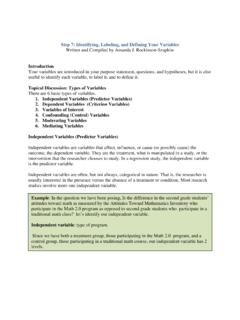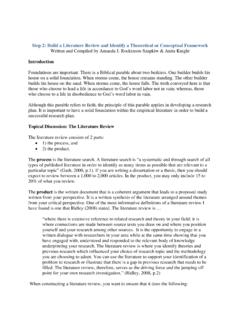Transcription of Step 4 Selecting and Justifying Your Research Design
1 Step 4: Selecting and Justifying your Research Design Written and Compiled byAmanda J. Rockinson-Szapkiw Introduction Before any great building is constructed, the builder analyses the situation and chooses building type. Once the type of building is identified, the builder begins sketching out the plans, setting a schedule, and obtaining the needed permits and materials. Consider Frank Lloyd Wright's Fallingwater. Wright didn't just start stacking bricks upon bricks and arrive at his creation, the construction of Fallingwater. He analyzed the various landforms, identified the type of building he desired to build, and designed the building on paper prior to the first stone being laid. That is, the genius of the building had already been realized prior to construction. Similarly, prior to conducting Research , you need to identify a Design or structure and then sketch the plan out ( sampling, method of data collection, etc.)
2 A Research Design guides decisions that need to be made about conducting the Research , for example: when and how often to collect data what data to gather and from whom how to analyze the data Here we talk about several different quantitative Research designs. We discuss when and why a Design is chosen. You will then identify the Design that is most appropriate for your Research and justify why it is the best choice. You do however need to read Research texts to fully understand Research designs and justify your choose. Some Research studies use mixed designs, so more than one Design can be chosen. A mixed method approach, that is using both a quantitative and qualitative Design , may also be chosen. A mixed methods approach requires that you conduct a full quantitative and a full qualitative study. In essence, if this approach is chosen, you are committing to conduct two studies.
3 Here we will only focus on quantitative Research designs. Topical Discussion: Research Designs There are two primary types of quantitative Research , descriptive, which asks, What is going on? and explanatory, which asks, Why is it going on? As such, there are Research designs that are descriptive and explanatory. Since researchers have posed numerous quantitative Research designs, both descriptive and explanatory, and they are too numerous to cover, we will focus our attention primarily on the major designs proposed by both Campbell and Stanley (1963) and Crowl (1993). We will examine the purpose of each Design and reasons why educational researchers choose specific designs. Figure 1 below overviews the different designs. Quantitative Research Group Descriptive Correlation Comparison Casual Comparative Pre- Quasi- True Relationship Predictive / Ex Post experimental experimental Experimental Facto Figure 1.
4 Research designs. Descriptive Designs. Purpose: The aim of descriptive studies is to understand what is in a specific situation with an identified population. For example, an educational researcher may want to know, What is the attitude of school counselors about the use of Response to Intervention (RtI)? Or What responsibilities do school counselors have in RtI as implemented in their school? The researcher does not attempt to manipulate or exert control over the phenomenon being studied, rather he or she observes and measures it as it occurs. The researcher does not seek to examine a causal relationship between variables; thus, there are no independent or dependent variables in a descriptive study. Descriptive studies are often used to gain knowledge to identify a problem for further, more sophisticated Research .
5 Descriptive studies vary in rigor; thus, if conducting Research for a thesis or dissertation, it is important to know the university policy on the use of descriptive studies for such endeavors. There are two types of descriptive studies. These types are often referred to as survey or observational Research : Longitudinal designs include the study a population over a period of time. This includes trend studies, cohort studies, and panel studies. Cross sectional designs include the study of individuals (usually an attitude or belief) at one point in time. Ex Post Facto Designs. Purpose: To examine the possible cause and effect relationship between variables that exist. A casual comparative Design is an ex post facto Research , non-experimental Design that is often used in educational Research for exploratory purposes.
6 A phenomena is studied after the fact; that is, after it occurred naturally or was already manipulated. For example, a researcher may want to examine male and female differences or drop out and non-drop out differences. The researcher may ask, is there a difference in male and female university students' social presence while participating in a 8 week online course? So, like descriptive studies, the researcher does not attempt to manipulate or exert control over the phenomenon being studied. However, unlike descriptive studies, the researcher does seek to examine a possible cause and effect relationship between variables; thus, there is an independent or dependent variable. Note that I said possible cause and effect. Due to the fact that extraneous variables are not controlled for in this Design , the results of the Research can only suggest that one variable may cause another.
7 A more rigorous experimental Design is needed to verify the results. A casual comparative Design is usually chosen by a researcher in order to gain information about a phenomena in which little is known. It also used when the researcher finds it too difficult, unethical, or impossible to manipulate the independent variable. And, although you will note that a causal-comparative Design , is almost identical to a pre-experimental Design , it is considered more creditable as long as selection threats to validity are addressed and different groups that are studied are as homogeneous as possible on all variables except the one under study. Correlational Designs. Purpose: Correlational Research examines the extent to which two or more variables relate to one another. For example, a researcher may desire to know if a relationship exists between high school GPA.
8 And College Board SAT scores or if SAT scores can predict college GPA. Some researchers consider correlational Research , observational Research as the researcher does not manipulate any variables. In the example, the researcher would only need to collect students' GPA and SAT. scores to conduct his or her study. As the questions imply, correlational Research designs include both prediction studies and relationship studies. The variables in a prediction study are referred to as the predictor and criterion, and the researcher is concerned with whether one or more variables can predict another variable. The variables in a relationship study are referred to as variables of interest, and researcher is concerned with how the variables understudy relate. The researcher who chooses to conduct correlational Research is simply examining if a relationship between or among variables exists.
9 The researcher cannot make statements about any cause and effect relationships because he or she does not know the direction of the cause and cannot guarantee that another variable in not influencing the relationship between variables. Researchers often choose to conduct correlational Research as exploratory or beginning Research to determine if more rigorous Research is warranted. If a correlational Design is chosen, the researcher needs to ensure that a theoretical or conceptual rationale for each variable under study is presented. The results of a correlational study demonstrate whether of not the variables relate. Experimental Research is needed to determine if a cause and effect relationship exists. Before discussing experimental designs, it is noteworthy to mention that some Research texts refer to or group correlational and causal comparative Research designs with in their discussion of observational designs.
10 Sometimes these designs are also discussed using different terminology. For example, Kazdin (2003) delineates between experimental and observational studies. He purports that the distinguishing characteristic between these two types of study is manipulation. In an experimental study, a researcher manipulates a variable or interest; whereas, in an observational study, a researcher observes the variable of interest and its associations. Kazdin (2003) discusses two types of observational studies: Case-control Design is defined as Design in which a researcher studies a variable of interest by forming groups who vary on that variable. For example, a researcher may want to examine male and female differences or drop out and non-drop out differences. The researcher may ask, Is there a difference in male and female university students'.


